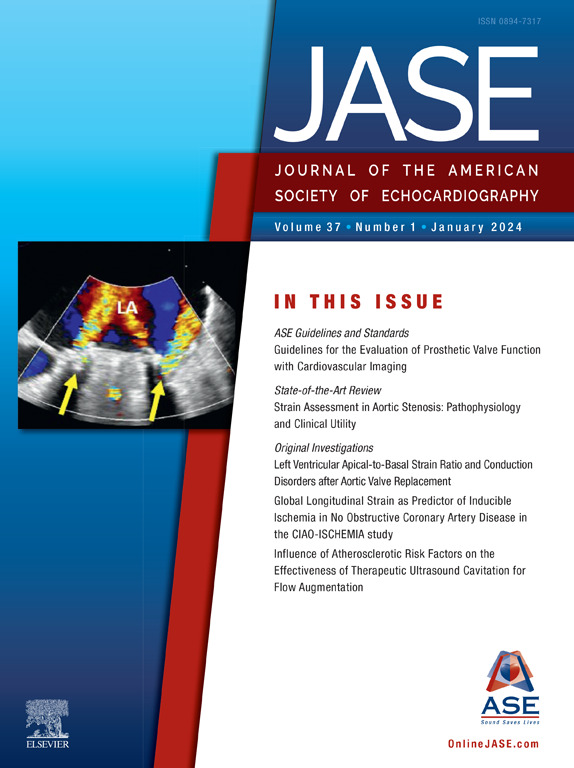Strain Reversus Sign: Diagnostic Role and Correlation With Cardiac Magnetic Resonance Findings in Constrictive Pericarditis
IF 6
2区 医学
Q1 CARDIAC & CARDIOVASCULAR SYSTEMS
Journal of the American Society of Echocardiography
Pub Date : 2025-09-01
DOI:10.1016/j.echo.2025.05.010
引用次数: 0
Abstract
Background
A typical echocardiographic longitudinal strain (LS) pattern of the left ventricle called strain reversus (SR) has been described in patients with constrictive pericarditis (CP). The aim of this study was to evaluate the prevalence of SR among pericardial diseases, its diagnostic role in CP, and its correlation with pericardial involvement assessed using cardiac magnetic resonance (CMR).
Methods
Eighty-five patients (mean age, 57 ± 17 years; 32.8% women) with pericardial diseases who underwent clinically indicated echocardiography and CMR were retrospectively enrolled.
Results
According to right heart catheterization findings, CP and nonconstrictive pericarditis were found in 24 and 61 patients, respectively. The prevalence of SR was higher in patients with CP compared with those with nonconstrictive pericarditis (91% vs 25%, P < .001) and was correlated with CP diagnosis (odds ratio [OR], 3.43; 95% CI, 1.39-5.49; P = .001). The addition of SR to the traditional Mayo Clinic criteria significantly improved the diagnostic accuracy of echocardiographic assessment of pericarditis, increasing the C statistic from 0.82 to 0.92 (P = .004), with a net reclassification improvement index of 0.198. SR was associated with pericardial thickening (OR, 2.30; 95% CI, 1.21-3.41; P = .001) and pericardial late gadolinium enhancement (OR, 1.55; 95% CI, 1.07-2.04; P = .036), but it was not linked to pericardial edema.
Conclusions
SR is an echocardiographic sign associated with CP and pericardial involvement detected on CMR that provides additional diagnostic value to the traditional Mayo Clinic criteria.
应变反转征象:在缩窄性心包炎中的诊断作用及与心脏磁共振表现的相关性
在缩窄性心包炎(CP)患者中出现了一种典型的超声心动图左心室纵向应变(LS)模式,称为应变逆转(SR)。本研究的目的是评估SR在心包疾病中的患病率,其在CP中的诊断作用,以及心脏磁共振(CMR)评估其与心包受累的相关性。方法回顾性分析85例经临床超声心动图和CMR检查的心包疾病患者(平均年龄57±17岁,女性32.8%)。结果经右心导管检查发现CP 24例,非缩窄性心包炎61例。与非缩窄性心包炎患者相比,CP患者的SR患病率更高(91% vs 25%, P < 001),并与CP诊断相关(优势比[OR], 3.43; 95% CI, 1.39-5.49; P = .001)。在梅奥诊所传统标准的基础上增加SR,可显著提高超声心动图对心包炎的诊断准确率,C统计值由0.82提高到0.92 (P = 0.004),净重分类改善指数为0.198。SR与心包增厚(OR, 2.30; 95% CI, 1.21-3.41; P = .001)和心包晚期钆增强(OR, 1.55; 95% CI, 1.07-2.04; P = .036)相关,但与心包水肿无关。结论ssr是CMR检测到的与CP和心包受累相关的超声心动图征象,为传统的梅奥诊断标准提供了额外的诊断价值。
本文章由计算机程序翻译,如有差异,请以英文原文为准。
求助全文
约1分钟内获得全文
求助全文
来源期刊
CiteScore
9.50
自引率
12.30%
发文量
257
审稿时长
66 days
期刊介绍:
The Journal of the American Society of Echocardiography(JASE) brings physicians and sonographers peer-reviewed original investigations and state-of-the-art review articles that cover conventional clinical applications of cardiovascular ultrasound, as well as newer techniques with emerging clinical applications. These include three-dimensional echocardiography, strain and strain rate methods for evaluating cardiac mechanics and interventional applications.

 求助内容:
求助内容: 应助结果提醒方式:
应助结果提醒方式:


